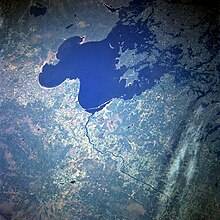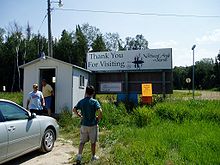Northwest Angle: Difference between revisions
Neutrality (talk | contribs) |
→Politics and popular culture: copyedit for redundancy |
||
| Line 18: | Line 18: | ||
==Politics and popular culture== |
==Politics and popular culture== |
||
Due to laws restricting fishing, some residents of the |
Due to laws restricting fishing, some residents of the Northwest Angle suggested leaving the United States and joining Canada in 1997. The following year, [[United States House of Representatives|U.S. Representative]] [[Collin Peterson]] proposed a constitutional amendment that would allow the residents of the Northwest Angle, which is part of his district, to vote on seceding from the United States and joining Canada, angering the leaders of [[Red Lake Indian Reservation]], which holds most of the Northwest Angle's land.<ref>http://news.minnesota.publicradio.org/features/199808/17_radila_angle-m/</ref><ref>http://minnesota.publicradio.org/collections/special/2006/campaign/congress/peterson/</ref> The area is one of several distinct [[regions of Minnesota]]. |
||
Author [[Tim O'Brien (author)|Tim O'Brien]] popularized knowledge of the location with his bestselling novel, ''[[In the Lake of the Woods]]'', set in the Angle. |
Author [[Tim O'Brien (author)|Tim O'Brien]] popularized knowledge of the location with his bestselling novel, ''[[In the Lake of the Woods]]'', set in the Angle. |
||
Revision as of 02:31, 5 December 2008


The Northwest Angle, known simply as the Angle by locals, and coterminous with Angle Township, is a part of northern Lake of the Woods County, Minnesota that is the only part of the United States outside Alaska that is north of the 49th parallel. That parallel is the northern boundary of the 48 contiguous states extending eastward from the west coast along the northern boundaries of Washington, Idaho, Montana, North Dakota, and part of Minnesota to the Northwest Angle. Farther east, U.S. territory does not extend that far north. Map projections sometimes create an optical illusion that Maine extends farther north than that; that illusion does not occur in maps in which parallels of latitude are straight lines. Like Alaska; Point Roberts, Washington; Alburgh, Vermont (there are three bridges over United States' water into Alburgh); and Elm Point, Minnesota (also at Lake of the Woods), the Northwest Angle cannot be reached from the rest of the United States without either going through Canada, flying in via small aircraft, or crossing water—specifically, the Lake of the Woods. A sizable portion of the Angle is held in trust by the Red Lake Indian Reservation (Ojibwa). The total population of the Angle was 152 at the 2000 census.
Origin
The Treaty of Paris, concluded between the United States and Great Britain at the end of the American Revolutionary War, stated that the boundary between U.S. territory and the British possessions to the north would run "…through the Lake of the Woods to the most northwestern most point thereof, and from thence on a due west course to the river Mississippi…" The parties did not suspect that the source of the Mississippi, Lake Itasca (then unknown to European explorers), was south of that point, and that thus the entire Mississippi was too far south to be intersected by a line running west from the Lake of the Woods. A factor in this mistake was the use of the Mitchell Map during the treaty negotiations; that map showed the Mississippi extending far to the north. In the Anglo-American Convention of 1818, the error was corrected by having the boundary run due south from the northwest point of the lake to the 49th parallel and then westward along it. When a survey team led by David Thompson finally located the northwestern most point of the lake and surveyed this north-south line, it was found to intersect other bays of the lake and therefore cut off a portion of U.S. territory, now known as the Northwest Angle.
Geography

According to the United States Census Bureau, Angle Township has a total area of 596.3 square miles (1,544.5 km²) of which 123.09 square miles (318.81 km²) is land and 473.2 square miles (1,225.7 km²) (79.36%) is water. The land includes several islands, including Oak Island, and two small capes that are below (south of) the 49th parallel north in the extreme southwest part of the township, south of the southeast corner of Manitoba, and not far from the northeast corner of Roseau County. Of the 2000 census population of 152, there were 118 living on the mainland, and 34 persons on the islands in Lake of the Woods. All of the populated islands are north of the 49th parallel. The mainland portion of the township north of the 49th parallel has an area of 116.632 square miles (302.08 km2). The total land area of all islands is 6.303 square miles (16.32 km2), and the two capes total 100 acres (0.16 sq mi; 40.47 ha). The township has the last one-room public school in the state. The border crossing (image) is unstaffed. Travelers using the single gravel road into the Angle are expected to use a telephone at Jim's Corner to contact Canadian or U.S. Customs and make their declarations.
Elm Point and Buffalo Point
Elm Point, in Lake of the Woods County, is a small cape southwest of the Northwest Angle. It borders Canada and may be separated by land from the continental United States. Buffalo Point, much smaller than Elm Point and to its east, might also be considered a U.S. territory not connected by land to the rest of the United States.
Politics and popular culture
Due to laws restricting fishing, some residents of the Northwest Angle suggested leaving the United States and joining Canada in 1997. The following year, U.S. Representative Collin Peterson proposed a constitutional amendment that would allow the residents of the Northwest Angle, which is part of his district, to vote on seceding from the United States and joining Canada, angering the leaders of Red Lake Indian Reservation, which holds most of the Northwest Angle's land.[1][2] The area is one of several distinct regions of Minnesota.
Author Tim O'Brien popularized knowledge of the location with his bestselling novel, In the Lake of the Woods, set in the Angle.
The Danny Orlis series of books, a Christian fiction series for youth, were largely set in the Northwest Angle.
Demographics
As of the censusTemplate:GR of 2000, there were 152 people, 71 households, and 48 families residing in the township. The census records all 152 as White, one also being Hispanic. The population density was 1.2 people per square mile (0.5/km²). There were 272 housing units at an average density of 2.2/sq mi (0.9/km²).
Of the 71 households, 10 have children under the age of 18 living with them, 45 are married couples living together, one has a female householder with no husband present, and 22 are non-families. Seventeen households are made up of individuals and 4 have someone living alone who is 65 years of age or older. The average household size was 2.14 and the average family size was 2.53.
In Angle Township, 22 people are under the age of 18 (11 girls and 11 boys), 5 are between 18 and 24, 32 from 25 to 44, 74 from 45 to 64, and 19 are 65 years of age or older. The median age is 50 years. There are 58 adult women and 72 adult men.
The median income for a household in the township was $28,500, and the median income for a family was $31,250. Males had a median income of $28,500 versus $21,250 for females. The per capita income for the township was $13,932. About 13.3% of families and 12.3% of the population were below the poverty line. No one under 18 or over 65 lives in poverty.
See also
External links
- Angle Inlet School: Minnesota's last one-room school
- Marking the Northwest Angle by Roger E. Grimsley, PLS
- The Northwest Angle (radio programme transcript)
- Boundary Commission Coordinates
References
- "Northwest Angle, Minnesota". NASA Earth Observatory newsroom. Retrieved 2006-04-27.
